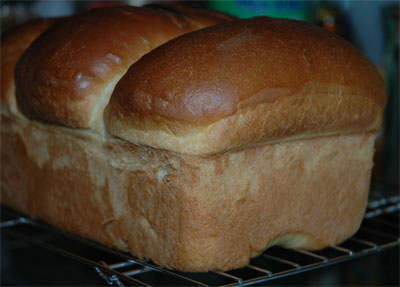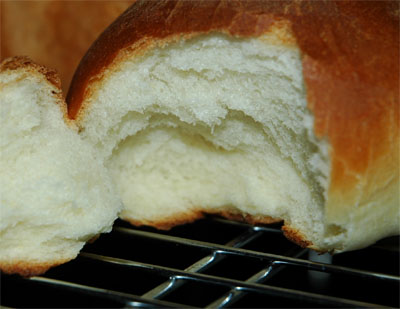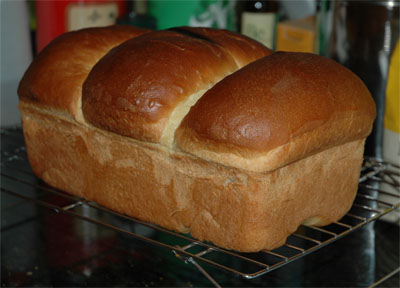
That's what I kept repeating to myself after last night's bread failure. If you've ever been to an Asian bakery, particularly a Chinese or a Japanese one, you'll often find "milk bread," a really soft and fluffy white bread loaf that's completely square. It's honestly one of the best taking breads I've ever had and I really love it, along with my mom. Unfortunately, we don't have it very often. There's a really great Japanese bakery in Markham that bakes really great bread, and after coming across a few recipes for Hokkaido Milk Loaf, I thought that I would also give it a try myself.
I don't really know much behind the story of the this bread, but I believe it's called Hokkaido Milk Loaf is because the original bread actually uses the expensive milk from Hokkaido, Japan. I actually found two recipes online for Hokkaido Milk Loaf, one which used butter while the other didn't and both not requiring the use of real Hokkaido milk. Unfortunately for me, both recipes are written purposely for a bread machine, something I don't have, which meant that I had to fiddle around with the directions. After some deliberation, I decided to try the recipe with butter first. Let's just say that was a complete failure. After baking, my bread came out completely flat and had the texture of a cake rather than a loaf of bread. To say that I was greatly disappointed would be an understatement. There are a few possible reasons that it turned out to be a failure: a) The recipe called for too little yeast. Three grams of yeast? That's nothing... b) I might have messed it up a bit right before I put it in the oven. Ooops! c) I might have over-proofed it. Since the recipe was for a bread machine, I decided to actually go out of my way to purchase some instant yeast and try it out. Now, I have no experience with instant yeast whatsoever; I've always been an active yeast kind-of-girl. Thus, with my inexperience with instant yeast, there is a good probability that I might have over-proofed my bread.

Whatever the reason, my failure at my first attempt at milk bread did not discourage me. I woke up this morning and tried out the second recipe, this time going back to my familiar active dry yeast. The results? Major success! The bread rose beautifully...as much as three times compared to my failed milk loaf. The texture is really soft and fluffy, with a close grain, very similar to the milk loaves that I've eaten in the past. It's definitely a bread that I will be making again in the near future!

There were a few things I changed. I kept true to the ingredients and the amount used, but I changed the directions because I used a stand mixer rather than a bread machine. Furthermore, I didn't have a extra-long loaf pan; rather, I used an 9x5 inch loaf pan. Therefore, I used 3 of the 4 balls of dough to make the loaf, and with the leftover ball, I simply split it into 4 equal parts and rolled them into individual buns.
I've included the recipe below. Credit for the recipe belongs to Angie's Recipes; however, I've adjusted the directions to be more user-friendly for bakers who don't own bread machines like myself.

Hokkaido Milk Loaf
Adapted from recipe here
Makes one 9x5-inch loaf and 4 small buns
- 540 g bread flour
- 60 g cake flour
- 10 g dry active yeast
- 30 g milk powder
- 80 g sugar
- 9 g salt
- 1 large egg, lightly beaten
- 250 g warm fresh milk (105°F-115°F)
- 150 g tepid whipping/heavy cream (90°F)
- Dissolve yeast and 1 tablespoon of the sugar in the warm milk. Let stand until foamy, about 10 minutes. Sift together the bread flour, cake flour and milk powder. Set aside.
- In the bowl of an electric mixer fitted with the flat (paddle) beater, combine the whipped cream, egg, salt, the remaining sugar and 1/2 cup of the flour mixture. Beat on medium speed until creamy, about 1 minute. Slowly add the yeast mixture and 1/2 cup of the flour and beat for 1 minute. Add the remaining flour mixture, 1/2 cup at a time, until thedough pulls away from the sides of the bowl. If dough remains sticky when all the flour runs out, add some bread flour, a handful at a time.
- Switch to the dough hook. Knead on medium-low speed, adding flour 1 tablespoon at a time if the dough sticks, until smooth and elastic, about 5-7 minutes. Cover with a damp towel and let rise until doubled in size, about 1½ to 2 hours.
(N.B. This is really subject to the weather in your area. I usually like to warm my oven a bit and then let the dough proof in the warm oven.) - Take out the dough and press out the gas produced during the proof. Divide it into 4 portions. Round up and let rest for about 20 minutes. Roll 3 of the 4 portions out, roll up swiss-roll style, pinch the ends and tuck under, and place in a greased 9-by-5 inch loaf pan. For the remaining portion, divide into 4 equal portions and shape them into buns (make whatever shapes you want!) and place on a parchment-lined or greased cookie sheet. Cover dough with a clean dishcloth and let the dough rise till is has increasedin size by about 80%.
- Preheat oven to 325°F. Brush top of bread with egg wash or milk. Bake for about 35 to 40 minutes (the buns will only need about 20). Take out of oven and let rest for 20 minutes. Turn the loaves out onto wire racks and let cool completely.
N.B. I've decreased the oven temp to 325°F because I was using a panwithout a lid. It's unfortunately that I don't own a Pullman pan to get atruly authentic-looking (as well as tasting) Hokkaido milk loaf, but this methodstill yields a great looking and great tasting loaf. But each baker knowshis/her oven best...so it's at your own disgression! Also, it's key to letthe loaf rest for 20 minutes before you even attempt at getting it out of thepan. Trust me...I've learned the hard way in the past by beingimpatient. You'll end up with a mis-shappened loaf. Give it the 20minutes to sweat so that when it comes time to turn it out of the pan, it'll slide right out without any problems.










Hi Bonita, your loaf is so lovely!
ReplyDeleteI like the beautiful shape of your loaf...in Chinese bread made in this shape it's called the "mountain-shape" loaf :)
I am very certain that the texture is much better than what I did! I used the bread machine to make the loaf...and I believe the texture will not be as fluffy as compared to a standing mixer.
Thanks for the lovely comment HH! The bread definitely had a nice, soft and fluffy texture to it. I was worried at first though because I myself messed up on the steps when I was experimenting with my own method, but it turned out all right in the end. And thanks to you, because it was your lovely post that really convinced me to make the bread!
ReplyDelete